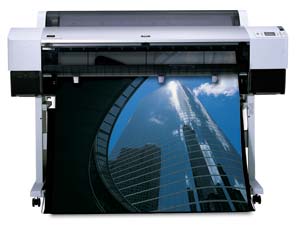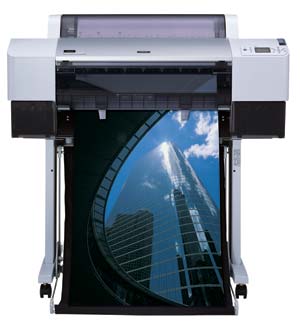ItÝs not often you see a printer manufacturer being transparent about the cost of its consumables, but for its latest range of wide format machines, Epson is being upfront about ink and paper costs with a view to dispelling the myth that inkjets are expensive to run. By Greg Corke.
In printing circles Epson is probably best known for its home and professional imaging products – areas where it enjoys great success. However, in the CAD sector, things are different, and pitted against the seemingly untouchable HP, Epson, like so many other large format inkjet print manufacturers, doesnÝt often get a look in.
With the brand, the technology, competitive prices and an extremely loyal customer base, HP is an extremely hard nut to crack. But while companies such as Oc? have challenged HP by delivering machines capable of production level colour printing, Epson is playing to its own strengths, those of print quality and low maintenance costs.
Aiming for the top slice of the CAD/GIS market, Epson is targeting users who require high quality prints of renderings, photographs or colour maps, rather than lines, arcs and circles. And at the same time the company is being up front about exactly how much its machines cost to run.
The product range
EpsonÝs CAD/GIS large format product range is made up of three products: the Stylus Pro 4400 (A2+), the Stylus Pro 7400 (A1), and Stylus Pro 9400 (B0+). All three printers use the companyÝs Piezo print head technology, coupled with its pigment-based Ultrachrome ink. Unlike most inkjet systems, which use thermal technology to deposit ink, EpsonÝs Piezo print head technology uses a change in voltage to apply its droplets. According to Epson, Piezo has greater print accuracy than thermal inkjet technology, but perhaps more importantly from a cost perspective, the print heads do not need to be replaced over the lifetime of the printer. Continual heating puts a strain on thermal print heads, which means they need to be changed periodically.
All three Stylus Pro models are CMYK, featuring Cyan, Magenta, Yellow and Black inks. Cartridges are available in sizes of 220ml or 110ml, and while four cartridges are standard on the Stylus Pro 4400 (A2+), both the Stylus Pro 7400 (A1) and Stylus Pro 9400 (B0+) are able to carry two cartridges of each colour to maximise unattended operation. Cartridges can also be changed when printing.
Single roll feed paper delivery is standard across the entire range, though the Stylus Pro 4400 (A2+) also features a paper tray at the front for individual sheets. In addition, all units feature a straight path feed from the rear so media up to 1.5mm in thickness can be accommodated without any problem. This is great for those who need to print directly onto presentation boards.
All machines feature standard UBS 2.0 and Firewire interfaces, though the printers also plug directly into Ethernet networks. In a network environment, prints are processed on individual PCs using the supplied Windows or AutoCAD Heidi drivers and a dedicated print server stores and manages all the print data.
Speed and quality
The Epson Stylus Pro 4400, 7400, and 9400 are not workhorse large format printers, like HPÝs DesignJet 1000 Series, but that doesnÝt mean they are slow either. At 720dpi, the Stylus Pro 7400 can output a full colour A1 print on matte paper in just six minutes with line work coming in under four. In draft mode this is reduced even further.
In terms of quality, results are impressive, particularly when printing full colour on premium glossy photo paper. However, the quality on matte paper is also remarkable, particularly when you consider a standard ISO 400 A1 print will only cost you a shade over ú1.50. The colours arenÝt as bright and the definition not as crisp as on more expensive media types, but for presentations and posters the quality is more than adequate.
{mospagebreak}
The bottom line
The running costs of inkjet printers are often hidden. Indeed, in the consumer sector itÝs got to a stage where itÝs almost cheaper to buy a brand new printer than to replace the ink cartridges.
While this potential land fill nightmare doesnÝt translate to the wide format sector, ongoing costs – particularly from paper and inks – can still be high. In an attempt to make these costs much more transparent, Epson has developed an online tool to help users to better estimate exactly how much different types of prints will cost.
Users simply select their printer model number, cartridge size, media size and type, and print resolution, and the system will calculate a print cost per page based on an industry standard ISO 400 image. ItÝs actually quite surprising how cost effective some prints are, and it makes it much easier to make informed decisions as to which media offers the best price/performance. N.B. At the time of writing this facility was only available on CD ROM, but it will go online in February.
All other costs – such as those relating to a one time service required during the lifetime of the printer – are not included here, but these are minimal. However, in relation to other ongoing costs, Epson is keen to stress that it never needs to replace its print heads, which can be expensive in the long term for thermal ink jet printers.
Conclusion
Manufacturers have always said that to get the best out of any inkjet printer the best quality ink and media need to be used. While this is still true, print quality on lower cost media has improved dramatically over the years and with EpsonÝs latest Stylus Pro printers, users can even achieve excellent full colour results on standard matte paper.
In addition, Epson should be applauded for making its ongoing print costs more transparent, but with a list price more expensive than some of its competitors, itÝs probably a necessary marketing tool in this ultra competitive marketplace. While other vendors may offer a lower entry price point, ongoing running costs from extras such as print heads, can soon mount up.
Most people wouldnÝt buy a car without knowing how many miles per gallon it does, so why should it be any different for a printer that costs thousands of pounds?
| Product: Epson Stylus Pro 4400 (A2+) | Price: £1,395 |
| Product: Epson Stylus Pro 7400 (A1) | Price: £2,195 |
| Product: Epson Stylus Pro 9400 (B0+) | Price: £4,095 |
| Web: www.epson.co.uk www.colourgen.com |








